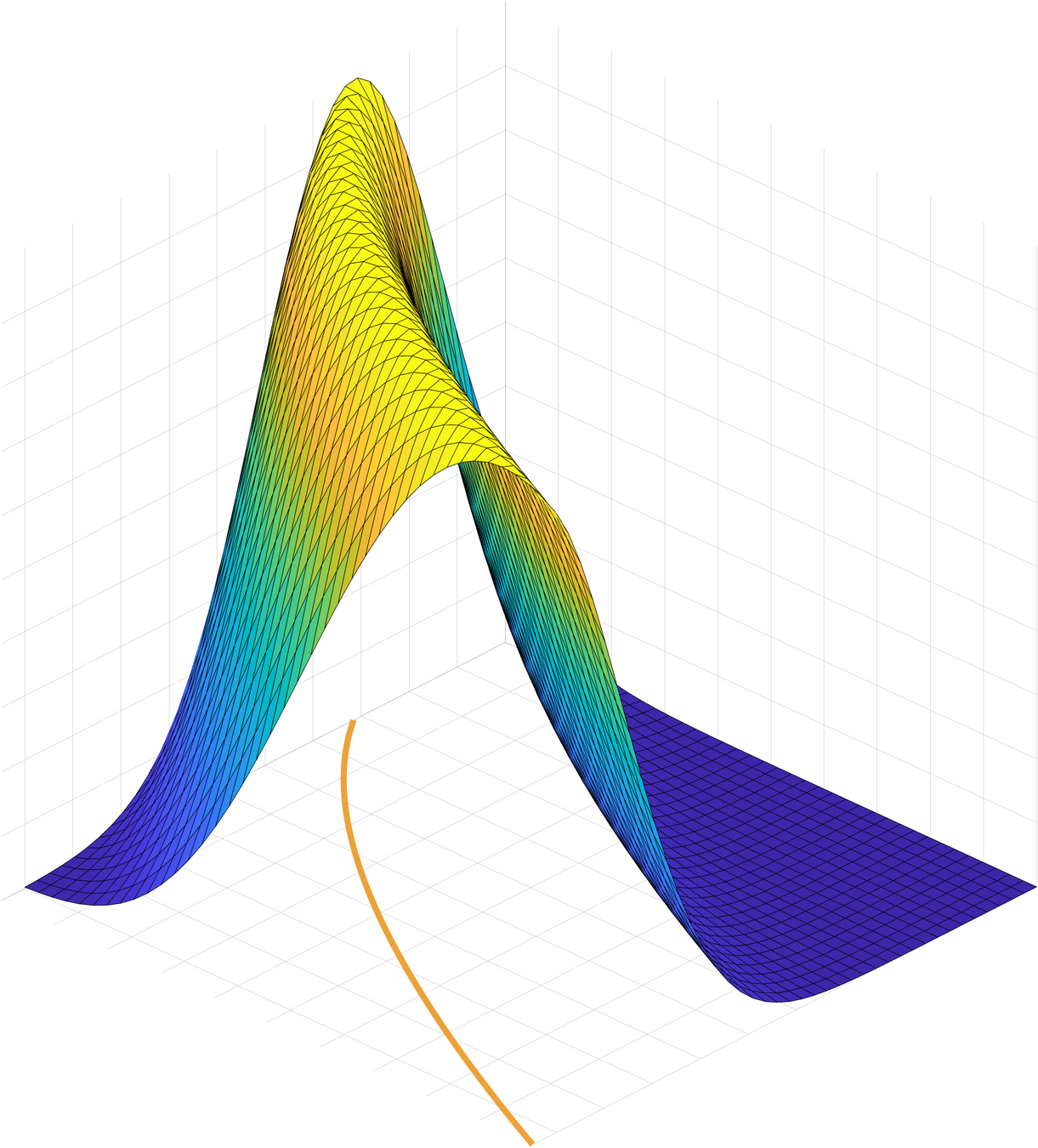Spaces of measures with nonnegative cross-curvature
Flavien Léger
joint work with Gabriele Todeschi and François-Xavier Vialard

\(\forall (\xi,\eta),\)
Introduction: the MTW tensor
\[\mathfrak{S}_c(x,y)(\xi,\eta)=(c_{ik\bar m} c^{\bar m n} c_{n \bar\jmath\bar\ell}-c_{i\bar\jmath k\bar\ell})\xi^i\eta^{\bar\jmath}\xi^k\eta^{\bar\ell}\]
\(X,Y,\) \(d\)-dimensional manifolds, \(c\in C^4(X\times Y)\), \(\nabla^2_{xy}c(x,y)\) nonsingular
MTW conditions
MTW tensor
(Ma–Trudinger–Wang ’05)
\[\mathfrak{S}_c(x,y)(\xi,\eta)\geq \kappa \lvert\xi\rvert_x^2 \lvert\eta\rvert_{x,y}^2\]
\(\kappa>0\)
\(\kappa=0\)
(Ma–Trudinger–Wang ’05)
(Trudinger–Wang ’09)
\[\mathfrak{S}_c(x,y)(\xi,\eta)\geq0\]
(Kim–McCann ’10)
\[\mathfrak{S}_c(x,y)(\xi,\eta)\geq \kappa \lvert\xi\rvert_x^2 \lvert\eta\rvert_{x,y}^2-C\lvert\langle \xi,\eta\rangle\rvert \lvert\xi\rvert\lvert\eta\rvert\]
(Loeper–Villani ’10)
⏵ \(\forall (\xi,\eta),\,\,\xi\perp\eta\)
Nonnegative cross-curvature (NNCC)
⏵ \(\forall (\xi,\eta),\)
⏵
Motivation 1: principal–agents problems
\(\Psi^c=\) set of \(c\)-concave functions
\[\phi^c(x)\coloneqq\min_{y\in Y} c(x,y)+\phi(y)\]
\(\Psi^c\) is a convex set (of functions)
T H E O R E M (FIGALLI–KIM–MCCANN '11)
If \(c\) has NNCC + other assumptions then
\[T_\phi(x)\coloneqq\operatorname*{argmin}_{y\in Y}\,\_\_\_\_\_\_\_\_\_\]
Motivations 2: Laplace integrals asymptotics
\[\iint_{X\times Y}e^{-u(x,y)/\varepsilon}\,dr(x,y)\]
\(u\) vanishes on \(\Sigma=\{(x,T(x)) : x\in X\}\)

$$\Sigma$$
$$Y$$
\(X,Y\) \(u\colon X\times Y\to\mathbb{R}\), \(u(x,y)\geq 0\)
Behavior as \(\varepsilon\to 0\) of
Motivations 2: Evolution variational inequalities
\((X,d)\) metric space
Convergence rate
EVI
\((X,d)\) non-positively curved, Mayer/Jost
Ambrosio–Gigli–Savaré
\(\mathcal{E}\) convex on geodesics
\(\mathcal{E}\) convex on curves \(x(t)\) such that \(d^2(x,x_{n-1})\) is \(1\)-convex, i.e. \(t\mapsto d^2(x(t),x_{n-1})-t^2 \,d^2(x(1),x(0))\) is convex
\(t\mapsto (x(t),\bar y)\) is a c-segment if \[\nabla_yc(x(t),\bar y)=(1-t)\nabla_yc(x(0),\bar y)+t\nabla_yc(x(1),\bar y).\]
D E F I N I T I O N
Background
\(X,Y\) two \(d\)-dimensional manifolds,
\(c\in C^4(X\times Y)\), nondegenerate, twist,
\(X\times Y\) c-convex
T H E O R E M (KIM–MCCANN '10)
\(c\) has nonnegative cross-curvature iff for any c-segment \(t\mapsto (x(t),\bar y)\), \[\forall y\in Y,\quad t\mapsto c(x(t),\bar y)-c(x(t),y)\text{ is convex}.\]
Key observation
\(c\in C^1(X\times Y\). If \(x(t)\) is any curve such that \(t\mapsto c(x(t),\bar y)-c(x(t),y)\) is convex for every \(y\in Y\), then \((x(t),\bar y)\) is a c-segment.
D E F I N I T I O N (L–Todeschi–Vialard '24)
\((X\times Y,c)\) is an NNCC space if for each \((x_0,x_1,\bar y)\in X\times X\times Y\), there exists a path \(x(\cdot)\) from \(x_0\) to \(x_1\) such that \(\forall y\in Y\), \[c(x(t),\bar y)-c(x(t),y)\leq (1-t)[c(x_0,\bar y)-c(x_0,y)]+t[c(x_1,\bar y)-c(x_1,y)].\]
\((x(t),\bar y) \eqqcolon\) generalized c-segment.
\(X, Y\) two arbitrary sets, \(c\colon X\times Y\to\mathbb{R}\cup\{+\infty\}\).
(L–Todeschi–Vialard '24)
Some properties
Products preserve NNCC
If \((X^1\times Y^1,c^1)\) and \((X^2\times Y^2,c^2)\) are NNCC then so is \(((X^1\times X^2)\times(Y^1\times Y^2),c)\) with \[c((x^1,x^2),(y^1,y^2))=c^1(x^1,y^1)+c^2(x^2,y^2).\]
Certain projections preserve NNCC
\((X\times Y,c)\) NNCC space, \(\pi_1\colon X\to\underline{X}\), \(\pi_2\colon Y\to\underline{Y}\).\[\underline{c}(\underline{x},\underline{y})=\inf\{c(x,y) : \pi_1(x)=\underline{x},\pi_2(y)=\underline{y}\}\] Additional assumptions. Then \((\underline{X}\times \underline{Y},\underline{c})\) is NNCC
\((\mathcal{P}_2(\mathbb{R}^n)\times \mathcal{P}_2(\mathbb{R}^n), W_2^2)\) is an NNCC space.
More generally \(X\), \(Y\) Polish spaces, \(c\in C(X\times Y)\).
If \((X\times Y,c)\) is an NNCC space then so is \((\mathcal{P}(X)\times \mathcal{P}(Y), \mathcal{T}_c)\).
T H E O R E M (L–Todeschi–Vialard '24)
The Wasserstein space is NNCC
A generalized c-segment for \(\mathcal{T}_c\) between \((\mu_0,\nu)\) and \((\mu_1,\nu)\) is given by \((\mu(t),\nu)\)
⏵ \((T_0,S)\) optimal coupling of \((\mu_0,\nu)\)
⏵ \((T_1,S)\) optimal coupling of \((\mu_1,\nu)\)
⏵ for each \(\omega\in\Omega\), \(t\mapsto (T_t(\omega),S(\omega))\) is a \(c\)-segment
⏵ \(\mu(t)=(T_t)_\#\mathbb{P}\)
\((\Omega,\mathcal{F},\mathbb{P})\)
\(T_0,T_1\colon\Omega\to X\)
\(S\colon\Omega\to Y\)
\[\mathcal{T}_c(\mu,\nu)=\inf_{\pi\in\Pi(\mu,\nu)}\int c(x,y)\,d\pi\]
More examples of NNCC spaces
Bures–Wasserstein
Gromov–Wasserstein \(\mathbf{X}=[X,f,\mu]\) and \(\mathbf{Y}=[Y,g,\nu]\)
\[\operatorname{GW}^2(\mathbf{X},\mathbf{Y})=\inf_{\pi\in\Pi(\mu,\nu)}\int\lvert f(x,x')-g(y,y')\rvert^2\,d\pi(x,y)\,d\pi(x',y')\,.\]
Unbalanced OT
Application: EVIs
EVIs
\(c\colon X\times X\to\mathbb{R}_+\), \(\mathcal{E}\colon X\to\mathbb{R}\)
Convergence rates:
EVI
\(c=W_2^2, \,\,\mathcal{T}_c,\,\, \operatorname{GW}^2,\,\, \operatorname{BW}^2\dots\)
EVIs
⏵ \((X\times X,c)\) NNCC space
⏵ \(\mathcal{E}\) convex on generalized c-segments \((x(t),x_{n-1})\)
⏵ \(c\) satisfies \[\liminf_{t\to 0}\frac{c(x(t),x(0))}{t}=0.\]
Then EVI.
T H E O R E M (L–Todeschi–Vialard '24)
EVI
Thank you!
(Moka-10 2024-06-04) Spaces of measures with nonnegative cross-curvature
By Flavien Léger
(Moka-10 2024-06-04) Spaces of measures with nonnegative cross-curvature
- 366



